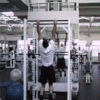풀업(운동)
Pull-up (exercise)
풀업은 상체에 힘을 주는 운동입니다.풀업(pull-up)은 몸을 손으로 매달고, 일반적으로 어깨 너비보다 넓은 거리에서 막대나 기타 도구를 잡고 끌어올리는 폐쇄형 체인 운동입니다.이렇게 되면 팔꿈치가 휘어지고 어깨가 늘어나서 팔꿈치를 몸통으로 가져옵니다.
풀업은 상체의 여러 근육을 형성하는데, 여기에는 latissimus dorsi, trapezius, bicps brachii가 포함됩니다.풀업은 오버핸드(발음), 언더핸드(수파)(때로는 턱걸이), 중립 또는 회전 손 위치로 수행할 수 있습니다.
일부 단체에서는 풀업을 체력 테스트의 구성 요소로 사용하기도 하고, 일부 스포츠의 컨디션 조절 활동으로 사용하기도 합니다.
움직임.
바에 매달리는 것부터 시작해서 몸을 수직으로 끌어올립니다.참가자는 맨 위 자세에서 팔과 어깨가 완전히 펴질 때까지 몸을 숙입니다.[1]상단 끝의 움직임 끝 범위는 가슴에서 바까지와 같이 턱 위 또는 더 높은 위치에 있을 수 있습니다.[2]
풀업(pull-up)은 팔꿈치의 굴곡과 어깨 관절의 추가 또는 확장을 수반하는 폐쇄된 체인의 복합적인 움직임입니다.[1][3][4]추골근, 추골근, 추골근은 풀업 초기에 가장 활동적이고, 추골근, 추골근은 움직임의 중간에 최대 활동에 도달하며, 추골근과 추골근은 움직임의 정상에서 최대 활동을 경험합니다.[5]근육 활성화 측면에서 풀다운과 유사한 점이 있습니다.[6]
2017년의 한 연구는 뚜렷한 악력이 중성 악력보다 중간 사다리꼴을 더 많이 활성화시킨다는 것을 발견했지만, 전반적으로 다른 악력 변형의 근육 활성화는 비슷했습니다.[7]근육 활성화는 풀업을 개별적으로 완료하느냐, 반복 사이에 쉬지 않고 세트로 완료하느냐에 따라 크게 차이가 나는데, 근육과 힘줄 스트레칭 리바운드로 더 효율적입니다.[8]
풀업과 같은 오버헤드 동작은 액막하 공간을 줄이고 어깨가 부딪힐 위험이 있습니다.한 연구에 따르면, 손을 어깨 너비로 벌린 뚜렷한 그립 풀업은 연구된 다른 변형보다 충돌 위험을 덜 초래했습니다.[9]
변주곡
풀업은 들뜸 그립, 중립 그립 또는 발음 그립으로 수행할 수 있습니다. 장치는 풀업 중에 그립을 회전시킬 수 있습니다.[10][11]턱걸이로 하는 풀업은 턱걸이라고 합니다.[1][7]다른 폭의 손 위치를 사용하여 풀업을 완료할 수 있습니다. 연구 결과에 따르면 참가자들은 어깨 너비보다 20에서 50% 더 넓은 그립을 자유롭게 선택할 수 있습니다.그립이 너무 넓으면 부상 위험이 증가하거나 레버 암이 길어져서 완료할 수 있는 반복 횟수가 감소할 수 있습니다.[6][9]
| 이름. | 묘사 | 사진. |
|---|---|---|
| 표준. |  | |
| 가중 | 난이도를 높이기 위해 딥 벨트, 웨이트 조끼 또는 다른 수단을 사용하여 웨이트를 추가합니다.[1] |  |
| 외팔 | 한 암 풀업은 한 암만 사용하여 차체를 들어올리는 방식으로 수행되며,[12] 다른 변형은 한 손가락만 사용하는 방식입니다.[13] |  |
| 키핑 | 다리를 흔들면 힘이 생기는 쉬운 버전입니다.키핑 풀업은 상체의 근육 활성화는 낮지만 하체와 코어의 활성화는 더 큽니다. 상체의 피로감을 느끼기 전에 더 빨리 수행하고 더 많은 반복을 완료하는 것이 가능합니다.[14]키핑 풀업은 부상의 위험성이 높은 것으로 간주되며 크로스핏 선수들의 어깨 부상의 주요 원인이 됩니다.[15] | |
| 머슬업 | 딥(dip)으로 전환되는 풀업. 풀업보다 더 어렵고 실행하는 데 상당한 강도와 기술이 필요합니다.체조에서 유래된 것으로 크로스핏에서도 인기가 있으며 키핑과 함께 연주할 수 있습니다.[16][17][18] |  |
| 어시스턴트 | 참가자의 유효 체중은 운동을 쉽게 하기 위해 저항 밴드, 평형추, 또는 발을 표면에 올려놓는 등의 방법으로 감소됩니다.보조 풀업은 보조 풀업을 할 수 없는 사람들 사이에서 당기는 힘을 증가시키는 데 사용될 수 있습니다.[1][19] |  |
| 편심 | 풀업의 맨 위 위치에서 시작하여 참가자는 점차 데드 행 위치로 몸을 낮춥니다.표준 풀업을 수행하는 단계로 사용할 수 있습니다.[1] |
장비.

풀업은 일반적으로 바를 사용하여 수행되며, 출입구 장착 바는 가정용 체육관에서 사용할 수 있도록 판매됩니다.[3][10]수건,[3] 회전 손잡이[3][11] 또는 체조 링을 잡고 완성할 수도 있습니다.[20]
사용하다

풀업은 상체의 힘, 지구력, 그리고 몸무게 대비 힘의 비율을 측정하는 일반적인 방법입니다.[1][21]풀업을 할 수 있는 힘은 소방, 경찰, 군대와 같은 일부 직업에서 직무와 관련된 일들과 관련이 있습니다.[21]
풀업은 많은 스포츠, 특히 암벽등반, 체조, 로프등반, 조정, 수영 등 당기는 힘이 필요한 스포츠의 컨디셔닝 활동으로 사용됩니다.[1][5]그들은 또한 경찰과 군대가 구성원들 사이에서 근육의 힘을 증가시키기 위해 사용합니다.[7]
몇몇 단체들은 소수의 여성 신입사원들이 풀업을 완료할 수 없다는 것을 알게 된 후 체력 테스트에서 여성들이 풀업 대신 굴곡진 팔걸이를 사용할 수 있도록 허용합니다.2003년 대학생 여성을 대상으로 한 연구에 따르면, 참가자의 3분의 1이 12주간의 전신 근력 운동 프로그램 후에 몸을 끌어올릴 수 있었다고 합니다.[21]
기네스 세계 기록
일본 해안경비대 다이버 아다치 겐타(Adachi Kenta)[22][23]가 2022년 651번의 풀업으로 87분 만에 세운 기네스 세계 기록.무게 추를 올린 것에 최대 무게를 더한 기네스 세계 기록은 2016년 스페인의 다비드 마르찬테가 104.55kg(230.5파운드)으로 세웠습니다.[24][25]
참고문헌
- ^ a b c d e f g h Ronai, Peter; Scibek, Eric (2014). "The Pull-up". Strength & Conditioning Journal. 36 (3): 88–90. doi:10.1519/SSC.0000000000000052. ISSN 1524-1602.
- ^ Coyne, Joseph; Tran, Tai; Secomb, Josh; Lundgren, Lina; Farley, Oliver; Newton, Robert; Sheppard, Jeremy (2015). "Reliability of pull up and dip maximal strength tests". Journal of Australian Strength and Conditioning. 23 (4). ISSN 1836-649X.
- ^ a b c d Snarr, Ronald L.; Hallmark, Ashleigh V.; Casey, Jason C.; Esco, Michael R. (2017). "Electromyographical Comparison of a Traditional, Suspension Device, and Towel Pull-Up". Journal of Human Kinetics (in Italian). 58 (1): 5–13. doi:10.1515/hukin-2017-0068. PMC 5548150. PMID 28828073.
- ^ Coombes, Jeff S.; Burton, Nicola W.; Beckman, Emma M. (2019). ESSA's Student Manual for Exercise Prescription, Delivery and Adherence- eBook. Elsevier Health Sciences. pp. 198–199. ISBN 978-0-7295-8658-0.
- ^ a b Urbanczyk, Caryn A.; Prinold, Joseph A. I.; Reilly, Peter; Bull, Anthony M. J. (2020). "Avoiding high-risk rotator cuff loading: Muscle force during three pull-up techniques". Scandinavian Journal of Medicine & Science in Sports. 30 (11): 2205–2214. doi:10.1111/sms.13780. ISSN 0905-7188. PMID 32715526. S2CID 220796735.
- ^ a b Ortega-Rodríguez, R.; Feriche, B.; Almeida, F.; Bonitch-Góngora, J.; Padial, P. (2021). "Effect of the Pronated Pull-Up Grip Width on Performance and Power-Force-Velocity Profile". Research Quarterly for Exercise and Sport. 92 (4): 651–658. doi:10.1080/02701367.2020.1762835. PMID 32669057. S2CID 220581421.
- ^ a b c Dickie, James A.; Faulkner, James A.; Barnes, Matthew J.; Lark, Sally D. (2017). "Electromyographic analysis of muscle activation during pull-up variations". Journal of Electromyography and Kinesiology. 32: 30–36. doi:10.1016/j.jelekin.2016.11.004. ISSN 1050-6411. PMID 28011412.
- ^ Vigouroux, L.; Cartier, T.; Rao, G.; Berton, É. (2022). "Pull-up forms of completion impacts deeply the muscular and articular involvements". Science & Sports. 38 (2): 150–160. doi:10.1016/j.scispo.2022.03.006. S2CID 251114906.
- ^ a b Prinold, Joe A. I.; Bull, Anthony M. J. (2016). "Scapula kinematics of pull-up techniques: Avoiding impingement risk with training changes". Journal of Science and Medicine in Sport. 19 (8): 629–635. doi:10.1016/j.jsams.2015.08.002. ISSN 1440-2440. PMC 4916995. PMID 26383875.
- ^ a b "The Best Pull-Up Bars". The New York Times. 22 February 2021. Retrieved 1 October 2022.
- ^ a b Youdas, James W.; Amundson, Collier L.; Cicero, Kyle S.; Hahn, Justin J.; Harezlak, David T.; Hollman, John H. (2010). "Surface Electromyographic Activation Patterns and Elbow Joint Motion During a Pull-Up, Chin-Up, or Perfect-Pullup™ Rotational Exercise". The Journal of Strength & Conditioning Research. 24 (12): 3404–3414. doi:10.1519/JSC.0b013e3181f1598c. ISSN 1064-8011. PMID 21068680. S2CID 22237474.
- ^ Miller, Delaney (19 September 2022). "How to do a One-Arm Pull-Up". Climbing. Retrieved 24 September 2022.
- ^ "Magnus Midtboe's Training: One-finger Pull-ups". Climbing. 7 December 2011. Retrieved 24 September 2022.
- ^ Dinunzio, Christopher; Porter, Nathaniel; Van Scoy, John; Cordice, Derrick; McCulloch, Ryan S. (2019). "Alterations in kinematics and muscle activation patterns with the addition of a kipping action during a pull-up activity". Sports Biomechanics. 18 (6): 622–635. doi:10.1080/14763141.2018.1452971. PMID 29768093. S2CID 21699036.
- ^ Nicolay, Richard W.; Moore, Laura K.; DeSena, Tyler D.; Dines, Joshua S. (2022). "Upper Extremity Injuries in CrossFit Athletes—a Review of the Current Literature". Current Reviews in Musculoskeletal Medicine. 15 (5): 402–410. doi:10.1007/s12178-022-09781-4. ISSN 1935-9748. PMC 9463423. PMID 35867271.
- ^ Matal, Megan A.; Barez, Fred; Lee, John; Wagner, David (2013). "Factors Contributing to Spiral Humerus Fracture During Muscle-Up Exercise". Proceedings of the ASME 2013 International Mechanical Engineering Congress and Exposition. Volume 3A: Biomedical and Biotechnology Engineering. doi:10.1115/IMECE2013-62643. ISBN 978-0-7918-5621-5.
- ^ Friedman, Michael V.; Stensby, J. Derek; Hillen, Travis J.; Demertzis, Jennifer L.; Keener, Jay D. (2015). "Traumatic Tear of the Latissimus Dorsi Myotendinous Junction: Case Report of a CrossFit-Related Injury". Sports Health: A Multidisciplinary Approach. 7 (6): 548–552. doi:10.1177/1941738115595975. PMC 4622375. PMID 26502450.
- ^ Walker, CW; Brunger, A.; Tucker, S.; Lee, R. (2017). "Comparison of Muscle Activity During a Ring Muscle Up and Bar Muscle Up". International Journal of Exercise Science: Conference Proceedings. 11 (5).
- ^ Johnson, Doug; Lynch, James; Nash, Kedren; Cygan, Joe; Mayhew, Jerry L. (2009). "Relationship of Lat-Pull Repetitions and Pull-Ups to Maximal Lat-Pull and Pull-Up Strength in Men and Women". The Journal of Strength & Conditioning Research. 23 (3): 1022–1028. doi:10.1519/JSC.0b013e3181a2d7f5. ISSN 1064-8011. PMID 19387371. S2CID 24597041.
- ^ Anderson, Wm G. (1932). "Comments on the "Push-Up and Pull-Up"". Research Quarterly. American Physical Education Association. 3 (1): 81–84. doi:10.1080/23267402.1932.10761532.
- ^ a b c Flanagan, S. P.; Vanderburgh, P. M.; Borchers, S. G.; Kohstall, C. D. (2003). "Training College-Age Women to Perform the Pull-Up Exercise". Research Quarterly for Exercise and Sport. 74 (1): 52–59. doi:10.1080/02701367.2003.10609064. PMID 12659476. S2CID 11511920.
- ^ Shimbun, The Yomiuri (28 May 2022). "Coast Guard diver sets Guinness Record for consecutive pull-ups". japannews.yomiuri.co.jp. Retrieved 24 September 2022.
- ^ "Most consecutive pull ups". Guinness World Records. 4 March 2022. Retrieved 24 September 2022.
- ^ "Heaviest weighted pull up (male)". Guinness World Records. Retrieved 24 September 2022.
- ^ Shiffer, Emily (12 March 2020). "Watch These Guys Try to Break the Unofficial Weighted Pull-Up World Record". Yahoo News. Retrieved 24 September 2022.
추가열람
- Beckham, George K.; Olmeda, Joshua J.; Flores, Alexandra J.; Echeverry, Julian A.; Campos, Alexus F.; Kim, Steven B. (2018). "Relationship Between Maximum Pull-up Repetitions and First Repetition Mean Concentric Velocity". Journal of Strength and Conditioning Research. 32 (7): 1831–1837. doi:10.1519/JSC.0000000000002431. PMID 29351165. S2CID 23580065.
- Sánchez-Moreno, Miguel; Cornejo-Daza, Pedro Jesús; González-Badillo, Juan José; Pareja-Blanco, Fernando (2020). "Effects of Velocity Loss During Body Mass Prone-Grip Pull-up Training on Strength and Endurance Performance". Journal of Strength and Conditioning Research. 34 (4): 911–917. doi:10.1519/JSC.0000000000003500. PMID 32213783. S2CID 213281481.
- Sánchez-Moreno, Miguel; Rodríguez-Rosell, David; Pareja-Blanco, Fernando; Mora-Custodio, Ricardo; González-Badillo, Juan José (2017). "Movement Velocity as Indicator of Relative Intensity and Level of Effort Attained During the Set in Pull-Up Exercise". International Journal of Sports Physiology and Performance. 12 (10): 1378–1384. doi:10.1123/ijspp.2016-0791. PMID 28338365.


